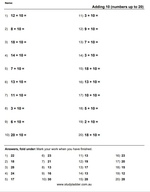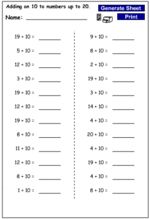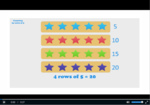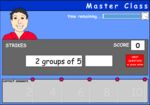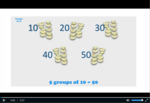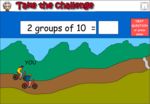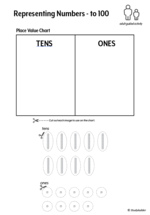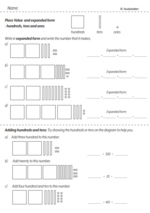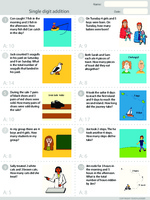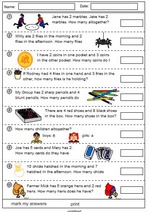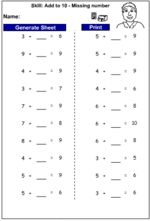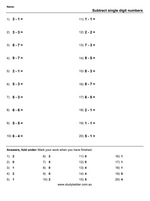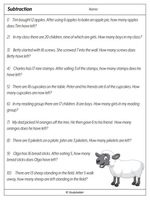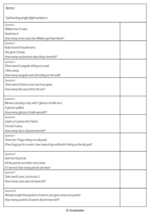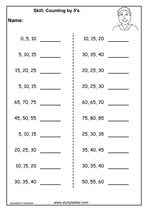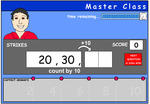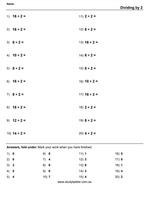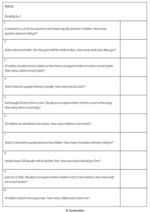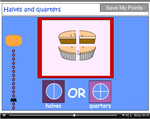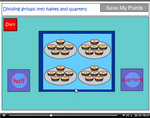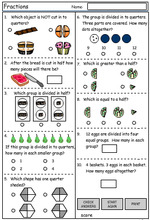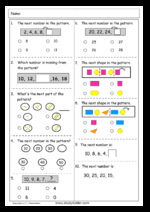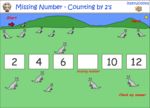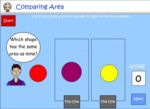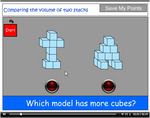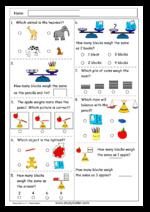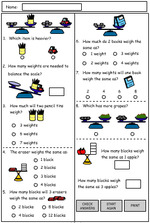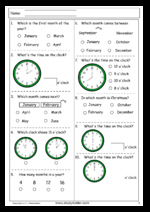Mathematics – Australia – Australian Curriculum
Number and Algebra
Number and place value
ACMNA026 – Investigate number sequences, initially those increasing and decreasing by twos, threes, fives and ten from any starting point, then moving to other sequences.
-
7 learning outcomes – click to view
Samples: Adding on 10 using blocks. Subtracting 10 using blocks. Adding 10. Groups of 2. Groups of 5. Groups of 10. Groups of 3.
-
Place value - adding 10
- Activities: 2 course, 0 extra
-
-
- Adding on 10 using blocks
- Tutorial
-
-
-
- Adding on 10 using blocks
- Practice
-
-
Adding 10 to two-digit numbers
- Activities: 6 course, 14 extra
-
-
- Adding 10
- Tutorial
-
-
-
- Adding 10
- Tutorial
-
-
-
- Adding on 10 using blocks
- Practice
-
-
-
- Adding 10 to numbers up to 100
- Practice
-
-
-
- Adding 10 (to two digits)
- Challenge
-
-
-
- Counting Forwards By 10
- Tutorial
-
Extra activities
-
-
- Adding 10 (numbers up to 20)
- Printable
-
-
-
- Adding 10 (numbers up to 100)
- Printable
-
-
-
- Drill - add on 10 to numbers up to 20
- Printable
-
-
-
- Drill Add On 10 to numbers Less 100
- Printable
-
-
-

- Add on 10 - Jump Strategy
- Practice
-
-
Groups of two
- Activities: 4 course, 7 extra
-
-
- Groups of 2
- Tutorial
-
-
-
- Counting in two's - rows
- Practice
-
-
-
- Counting in two's - groups
- Practice
-
-
-
- Groups of 2
- Tutorial
-
Extra activities
-
-
- Groups of 2
- Printable
-
-
-
- Groups of 2
- Printable
-
-
-

- Groups of 2
- Practice
-
-
-

- Groups of 2
- Challenge
-
-
-

- Groups of 2
- Assessment
-
-
-

- Multiply by adding lots of 2
- Practice
-
-
Groups of five
- Activities: 5 course, 14 extra
-
-
- Groups of 5
- Tutorial
-
-
-
- Rows of 5
- Practice
-
-
-
- Groups of 5
- Practice
-
-
-
- Groups of 5
- Tutorial
-
-
-
- Rows of 5
- Tutorial
-
Extra activities
-
-
- Groups of 5
- Printable
-
-
-
- Groups of 5
- Printable
-
-
-
- Groups of 5
- Printable
-
-
-
- Identifying the amounts in a group
- Tutorial
-
-
-
- Groups and rows of 5
- Tutorial
-
-
-
- Groups of 5
- Tutorial
-
-
-
- Rows of 5
- Tutorial
-
-
-

- Groups of 5
- Challenge
-
-
-

- Groups of 5
- Practice
-
-
-

- Multiply by adding lots of 5
- Practice
-
-
-

- Groups of 5
- Assessment
-
-
-

- Rows of five
- Practice
-
-
Groups of ten
- Activities: 6 course, 5 extra
-
-
- Groups of 10
- Tutorial
-
-
-
- Number of tens
- Practice
-
-
-
- Rows of 10
- Practice
-
-
-
- Groups of 10
- Practice
-
-
-
- Groups of 10
- Tutorial
-
-
-
- Rows Of 10
- Tutorial
-
Extra activities
-
-
- Groups of 10
- Printable
-
-
-
- Groups of 10
- Printable
-
-
-

- Groups of 10
- Challenge
-
-
-

- Rows of ten
- Practice
-
-
-

- Groups of 10
- Assessment
-
-
Number patterns and groups (of 3)
- Activities: 3 course, 1 extra
-
-
- Groups of 3
- Tutorial
-
-
-
- Rows of 3
- Tutorial
-
-
-
- Groups of 3
- Practice
-
Extra activities
-
-

- Groups of three
- Practice
-
-
-
7 learning outcomes – click to view
ACMNA027 – Recognise, model, represent and order numbers to at least 1000
-
5 learning outcomes – click to view
Samples: Write numbers – to 1000. Reading numbers – to 1000. Comparing numbers – to 1000. Ordinal numbers.
-
Writing numbers – to 1000
- Activities: 2 course, 2 extra
-
-
- Write numbers – to 1000
- Practice
-
-
-
- Writing numbers to 1000
- Printable
-
Extra activities
-
-
- Writing numbers to 1000
- Printable
-
-
-
- Write numbers to 1000
- Printable
-
-
Comparing numbers – to 1000
- Activities: 1 course, 1 extra
-
Ordinal numbers
- Activities: 5 course, 2 extra
-
-
- Ordinal numbers
- Tutorial
-
-
-
- Ordinal numbers
- Practice
-
-
-
- Ordinal numbers
- Tutorial
-
-
-
- Ordinal numbers
- Practice
-
-
-
- Ordinal numbers
- Practice
-
Extra activities
-
-

- Ordinal numbers
- Practice
-
-
-

- Ordinal numbers
- Practice
-
-
-
5 learning outcomes – click to view
ACMNA028 – Group, partition and rearrange collections up to 1000 in hundreds, tens and ones to facilitate more efficient counting
-
13 learning outcomes – click to view
Samples: Expanded notation. Expanded notation (21-100 - identify the value of the 'ones').
-
Expanded notation (11-30)
- Activities: 3 course, 1 extra
-
-
- Expanded notation
- Tutorial
-
-
-
- Expanded notation (11-30)
- Practice
-
Extra activities
-
-
- Expanded notation (11-30)
- Printable
-
-
Expanded notation (21-100)
- Activities: 3 course, 1 extra
-
Place value - tens and ones (to 100)
- Activities: 8 course, 3 extra
-
-
- Representing place value - to 100
- Printable
-
-
-
- Place Values
- Tutorial
-
-
-
- Place Values
- Tutorial
-
Extra activities
-
-
- Tens and ones - numbers up to 100
- Printable
-
-
-

- Identifying Place Value
- Practice
-
-
-

- Guessing game - Numbers to 100
- Practice
-
-
Counting in tens and ones
- Activities: 3 course, 3 extra
-
-
- Counting in tens and ones
- Practice
-
-
-
- Place value 100
- Practice
-
Extra activities
-
-
- Counting in tens and ones
- Printable
-
-
-
- Place value 100 concepts
- Printable
-
-
-
- Place value 100 - concepts Answer sheet
- Printable
-
-
Place value - hundreds, tens and ones (to 999)
- Activities: 4 course, 3 extra
-
-
- Place Value
- Tutorial
-
Extra activities
-
Place value - adding 10
- Activities: 2 course, 0 extra
-
-
- Adding on 10 using blocks
- Tutorial
-
-
-
- Adding on 10 using blocks
- Practice
-
-
Place value - adding multiples of 10
- Activities: 2 course, 0 extra
-
-
- Adding multiples of 10 using blocks
- Tutorial
-
-
-
- Adding multiples of 10 using blocks
- Practice
-
-
Place value - subtracting multiples of 10
- Activities: 1 course, 0 extra
-
Expanded notation (to 1000)
- Activities: 4 course, 2 extra
-
-
- Expanded form - numbers to 1000
- Practice
-
-
-
- Expanded form - numbers to 1000
- Practice
-
-
-
- Expanded form - what's the number
- Practice
-
Extra activities
-
-
- Expanded form and place value to 1000
- Printable
-
-
-
- Place value and expanded form to 1000
- Printable
-
-
-
13 learning outcomes – click to view
ACMNA029 – Explore the connection between addition and subtraction
-
12 learning outcomes – click to view
Samples: Adding ones. Adding single digit numbers. Adding single digit numbers (problem solving). Adding 10. Make 10.
-
Adding single-digit numbers - number skills
- Activities: 7 course, 17 extra
-
-
- Adding single digit numbers
- Tutorial
-
-
-
- Adding single digit numbers
- Tutorial
-
-
-
- Adding single digit numbers
- Tutorial
-
-
-
- Adding single digit numbers
- Practice
-
-
-
- Adding single digit numbers
- Challenge
-
-
-
- Add numbers less than 5
- Tutorial
-
Extra activities
-
-
- Adding single digit numbers
- Printable
-
-
-
- Add doubles - single digit numbers
- Printable
-
-
-
- Adding single digit numbers
- Printable
-
-
-
- Adding single digit numbers
- Printable
-
-
-
- Timed Challenge: Add numbers less than 5
- Challenge
-
-
-

- Add Single Digits Duck Game
- Practice
-
-
-
- Drill - Add numbers up to 10.
- Printable
-
-
-
- Drill - Doubles to 20
- Printable
-
-
-

- Drill - Doubles to 20 (Auto-Generated)
- Printable
-
-
-
- Add single digit numbers
- Printable
-
-
-

- Addition to 20 - with visual cues
- Practice
-
-
-

- Add numbers less than 5
- Assessment
-
-
-

- Add single digit numbers
- Assessment
-
-
-

- Combining to 20
- Practice
-
-
Adding single-digit numbers- problem solving
- Activities: 4 course, 9 extra
-
Adding 10 to two-digit numbers
- Activities: 6 course, 14 extra
-
-
- Adding 10
- Tutorial
-
-
-
- Adding 10
- Tutorial
-
-
-
- Adding on 10 using blocks
- Practice
-
-
-
- Adding 10 to numbers up to 100
- Practice
-
-
-
- Adding 10 (to two digits)
- Challenge
-
-
-
- Counting Forwards By 10
- Tutorial
-
Extra activities
-
-
- Adding 10 (numbers up to 20)
- Printable
-
-
-
- Adding 10 (numbers up to 100)
- Printable
-
-
-
- Drill - add on 10 to numbers up to 20
- Printable
-
-
-
- Drill Add On 10 to numbers Less 100
- Printable
-
-
-

- Add on 10 - Jump Strategy
- Practice
-
-
Make 10.
- Activities: 6 course, 4 extra
-
-
- Make 10
- Tutorial
-
-
-
- Make 10
- Tutorial
-
-
-
- Make 10
- Practice
-
-
-
- Make 10
- Practice
-
-
-
- Make 10 (20 questions)
- Practice
-
-
-
- Make 10 - Using a number line
- Practice
-
Extra activities
-
-
- Make 10
- Tutorial
-
-
-
- Make 10
- Printable
-
-
-
- Make 10 - Visual cues
- Practice
-
-
-

- Combination to 10
- Practice
-
-
Make 10 (problem solving)
- Activities: 2 course, 2 extra
-
-
- Make 10 (problem solving)
- Practice
-
-
-
- Make 10 (problem solving)
- Practice
-
Extra activities
-
-
- Make 10 (problem solving)
- Printable
-
-
-
- Make 10 (problem solving) Answer sheet
- Printable
-
-
Single-digit addition (missing number)
- Activities: 5 course, 10 extra
-
-
- Single digit addition (missing number)
- Challenge
-
Extra activities
-
-
- Single digit addition (missing number)
- Printable
-
-
-
- Single digit addition (missing number)
- Printable
-
-
-
- Single digit addition (missing number)
- Printable
-
-
-
- Single digit addition (missing number)
- Printable
-
-
-
- Single digit addition (missing number)
- Printable
-
-
-
- Single digit addition (missing number)
- Printable
-
-
-

- Addition with a missing number
- Assessment
-
-
Show addition and subtraction visually
- Activities: 1 course, 0 extra
-
Subtracting single-digit numbers
- Activities: 4 course, 12 extra
-
-
- Subtracting single digit numbers
- Tutorial
-
-
-
- Subtracting single digit numbers
- Practice
-
-
-
- Subtracting single digit numbers
- Challenge
-
Extra activities
-
-
- Subtract single digit numbers
- Printable
-
-
-

- Subtraction problem solving
- Assessment
-
-
-
- Subtract single digit numbers
- Printable
-
-
-
- Drill - Subtraction under 10
- Printable
-
-
-
- Subtract single digit numbers
- Tutorial
-
-
-
- Subtract single digits
- Tutorial
-
-
-

- Subtract from 10
- Practice
-
-
-

- Subtract single digit numbers
- Assessment
-
-
-

- Subtract single digit numbers
- Challenge
-
-
-

- Subtract single digit numbers
- Practice
-
-
-

- Subtract numbers less than 20
- Assessment
-
-
Subtracting single digits from up to 20 (problem solving)
- Activities: 2 course, 7 extra
-
-
- Single digit subtraction
- Practice
-
Extra activities
-
-
- Single digit subtraction
- Printable
-
-
-
- Single digit subtraction Answer sheet
- Printable
-
-
-

- Addition and subtraction problem solving
- Assessment
-
-
-

- Subtraction problem solving
- Assessment
-
-
12 learning outcomes – click to view
ACMNA030 – Solve simple addition and subtraction problems using a range of efficient mental and written strategies
-
8 learning outcomes – click to view
Samples: Adding 2 (problem solving). Add on to 5. Adding single digit numbers (problem solving). Make 10 (problem solving).
-
Adding single-digit numbers- problem solving
- Activities: 4 course, 9 extra
-
Make 10 (problem solving)
- Activities: 2 course, 2 extra
-
-
- Make 10 (problem solving)
- Practice
-
-
-
- Make 10 (problem solving)
- Practice
-
Extra activities
-
-
- Make 10 (problem solving)
- Printable
-
-
-
- Make 10 (problem solving) Answer sheet
- Printable
-
-
Subtracting 2 (problem solving)
- Activities: 1 course, 0 extra
-
-
- Subtracting 2 (problem solving)
- Practice
-
-
Subtracting from 10 (problem solving)
- Activities: 2 course, 3 extra
Extra activities
-
-
- Subtract From 10
- Printable
-
-
-
- Subtracting from 10
- Printable
-
-
-
- Subtracting from 10: Visual Cues
- Practice
-
-
Subtracting single-digit numbers (problem solving)
- Activities: 4 course, 3 extra
Extra activities
-
-
- Subtracting single digit numbers
- Printable
-
-
-
- Subtracting single digit numbers
- Printable
-
-
-
- Subtracting single digit numbers
- Printable
-
-
Subtracting single digits from up to 20 (problem solving)
- Activities: 2 course, 7 extra
-
-
- Single digit subtraction
- Practice
-
Extra activities
-
-
- Single digit subtraction
- Printable
-
-
-
- Single digit subtraction Answer sheet
- Printable
-
-
-

- Addition and subtraction problem solving
- Assessment
-
-
-

- Subtraction problem solving
- Assessment
-
-
8 learning outcomes – click to view
ACMNA031 – Recognise and represent multiplication as repeated addition, groups and arrays
-
11 learning outcomes – click to view
Samples: Groups of 2. Counting on number line (by 2's). Groups of 2. 2x Multiplication facts (times tables) - puzzle.
-
Groups of two
- Activities: 4 course, 7 extra
-
-
- Groups of 2
- Tutorial
-
-
-
- Counting in two's - rows
- Practice
-
-
-
- Counting in two's - groups
- Practice
-
-
-
- Groups of 2
- Tutorial
-
Extra activities
-
-
- Groups of 2
- Printable
-
-
-
- Groups of 2
- Printable
-
-
-

- Groups of 2
- Practice
-
-
-

- Groups of 2
- Challenge
-
-
-

- Groups of 2
- Assessment
-
-
-

- Multiply by adding lots of 2
- Practice
-
-
Counting on by two on a number line
- Activities: 7 course, 5 extra
-
-
- Counting on number line (by 2's)
- Tutorial
-
-
-
- Counting by 2
- Practice
-
-
-
- Counting by 2
- Practice
-
-
-
- Counting by 2
- Practice
-
-
-
- Counting by 2
- Tutorial
-
-
-
- Counting by 2
- Tutorial
-
-
-
- Counting by Two - Faster
- Tutorial
-
Extra activities
-
-
- Counting by 2
- Printable
-
-
-
- Counting by 2
- Tutorial
-
-
-

- Counting by 2
- Assessment
-
-
-

- Count on by 2 the next three numbers
- Practice
-
-
-

- Count by lots of 2
- Practice
-
-
2x tables
- Activities: 12 course, 6 extra
-
-
- Groups of 2
- Tutorial
-
-
-
- Learning 2x tables
- Tutorial
-
-
-
- Number Patterns (2x tables)
- Practice
-
-
-
- 2x tables - matching answers
- Practice
-
-
-
- 2x tables
- Practice
-
-
-
- 2x tables (20 questions)
- Practice
-
-
-
- 2x tables
- Challenge
-
-
-
- 2x tables
- Tutorial
-
-
-
- Time tables match (2x)
- Practice
-
-
-
- 3x tables learn
- Practice
-
-
-
- 2x Tables
- Practice
-
-
-
- Test 2 X
- Practice
-
Extra activities
-
-
- 2x tables
- Printable
-
-
-
- Times Tables Chart
- Printable
-
-
-

- 2X tables
- Practice
-
-
-

- 2X tables
- Assessment
-
-
-

- Drill - 2X tables (Auto-Generated)
- Printable
-
-
-
- Drill - 2X tables
- Printable
-
-
2x Multiplication facts (times tables) - puzzle
- Activities: 1 course, 0 extra
-
Groups of five
- Activities: 5 course, 14 extra
-
-
- Groups of 5
- Tutorial
-
-
-
- Rows of 5
- Practice
-
-
-
- Groups of 5
- Practice
-
-
-
- Groups of 5
- Tutorial
-
-
-
- Rows of 5
- Tutorial
-
Extra activities
-
-
- Groups of 5
- Printable
-
-
-
- Groups of 5
- Printable
-
-
-
- Groups of 5
- Printable
-
-
-
- Identifying the amounts in a group
- Tutorial
-
-
-
- Groups and rows of 5
- Tutorial
-
-
-
- Groups of 5
- Tutorial
-
-
-
- Rows of 5
- Tutorial
-
-
-

- Groups of 5
- Challenge
-
-
-

- Groups of 5
- Practice
-
-
-

- Multiply by adding lots of 5
- Practice
-
-
-

- Groups of 5
- Assessment
-
-
-

- Rows of five
- Practice
-
-
Counting on by five on a number line
- Activities: 6 course, 3 extra
-
-
- Counting on number line (by 5's)
- Tutorial
-
-
-
- Counting by 5
- Tutorial
-
-
-
- Counting by 5
- Practice
-
-
-
- Counting by 5
- Practice
-
-
-
- Counting by 5
- Practice
-
-
-
- Counting by 5
- Tutorial
-
Extra activities
-
-
- Counting by 5
- Printable
-
-
-

- Counting by 5
- Assessment
-
-
-

- Count by lots of 5
- Practice
-
-
5x tables
- Activities: 9 course, 7 extra
-
-
- Groups of 5
- Tutorial
-
-
-
- Learning 5x tables
- Tutorial
-
-
-
- Number Patterns (5x tables)
- Practice
-
-
-
- 5x tables
- Practice
-
-
-
- 5x tables
- Practice
-
-
-
- 5x tables (20 questions)
- Practice
-
-
-
- 5x tables
- Challenge
-
-
-
- 5x tables
- Tutorial
-
-
-
- Counting by 5's on a clock face
- Tutorial
-
Extra activities
-
-
- 5x tables
- Printable
-
-
-
- 5x tables
- Printable
-
-
-
- 5x tables
- Printable
-
-
-

- 5X tables
- Practice
-
-
-

- Drill - 5X tables (Auto-Generated)
- Printable
-
-
-
- Drill - 5X tables
- Printable
-
-
-

- 5X tables
- Assessment
-
-
Counting on by ten on a number line
- Activities: 6 course, 5 extra
-
-
- Counting on number line (by 10's)
- Tutorial
-
-
-
- Counting by 10
- Practice
-
-
-
- Counting by 10
- Practice
-
-
-
- Counting by 10
- Practice
-
-
-
- Counting by 10
- Tutorial
-
-
-
- Counting by 10
- Tutorial
-
Extra activities
-
-
- Counting by 10
- Printable
-
-
-
- Counting by 10
- Printable
-
-
-

- Numbers Problem Solving
- Assessment
-
-
-

- Count by lots of 10
- Practice
-
-
-

- Counting by 10
- Assessment
-
-
Groups of ten
- Activities: 6 course, 5 extra
-
-
- Groups of 10
- Tutorial
-
-
-
- Number of tens
- Practice
-
-
-
- Rows of 10
- Practice
-
-
-
- Groups of 10
- Practice
-
-
-
- Groups of 10
- Tutorial
-
-
-
- Rows Of 10
- Tutorial
-
Extra activities
-
-
- Groups of 10
- Printable
-
-
-
- Groups of 10
- Printable
-
-
-

- Groups of 10
- Challenge
-
-
-

- Rows of ten
- Practice
-
-
-

- Groups of 10
- Assessment
-
-
10x tables
- Activities: 9 course, 6 extra
-
-
- Groups of 10
- Tutorial
-
-
-
- Learning 10x tables
- Tutorial
-
-
-
- Number Patterns (10x tables)
- Practice
-
-
-
- 10x tables
- Practice
-
-
-
- 10x tables
- Practice
-
-
-
- 10x tables (20 questions)
- Practice
-
-
-
- 10x tables
- Challenge
-
-
-
- 10x tables
- Printable
-
-
-
- 10x tables
- Tutorial
-
Extra activities
-
-
- 10x tables
- Printable
-
-
-
- 10x tables
- Printable
-
-
-

- 10 X Tables
- Practice
-
-
-

- Drill - 10X tables (Auto-Generated)
- Printable
-
-
-
- Drill - 10X tables
- Printable
-
-
-

- 10X tables
- Assessment
-
-
Arrays
- Activities: 4 course, 0 extra
-
-
- Arrays 2, 5, 10 (up to 5 rows)
- Practice
-
-
-
- Arrays 2, 5, 10 (up to 10 rows)
- Practice
-
-
-
- Arrays
- Practice
-
-
-
- Arrays 2, 5, 10 (up to 5 rows)
- Practice
-
-
-
11 learning outcomes – click to view
ACMNA032 – Recognise and represent division as grouping into equal sets and solve simple problems using these representations
-
4 learning outcomes – click to view
Samples: Sharing equally. Dividing by 2. Dividing by 2 (problem solving). Using the division symbol. Share 12 equally.
-
Sharing between 2
- Activities: 0 course, 5 extra
Extra activities
-
-

- Sharing equally
- Practice
-
-
-

- Share 12 equally
- Practice
-
-
-

- Share 16 equally
- Practice
-
-
-

- Share 24 equally
- Practice
-
-
-

- Share 36 equally
- Practice
-
-
Dividing by 2
- Activities: 4 course, 1 extra
-
-
- Dividing by 2
- Tutorial
-
-
-
- Dividing by 2
- Practice
-
-
-
- Dividing by 2
- Practice
-
-
-
- Dividing by 2
- Tutorial
-
Extra activities
-
-
- Dividing by 2
- Printable
-
-
Dividing by 2 (problem solving)
- Activities: 2 course, 3 extra
-
-
- Dividing by 2 (problem solving)
- Practice
-
-
-
- Share between two - 2
- Practice
-
Extra activities
-
-
- Dividing by 2 (problem solving)
- Printable
-
-
-
- Dividing by 2 (problem solving)
- Printable
-
-
-
- Dividing by 2 (problem solving)
- Printable
-
-
Using the division symbol
- Activities: 3 course, 0 extra
-
-
- Using the division symbol
- Tutorial
-
-
-
- Using the division symbol
- Practice
-
-
-
- Dividing using division symbol
- Tutorial
-
-
-
4 learning outcomes – click to view
Fractions and decimals
ACMNA033 – Recognise and interpret common uses of halves, quarters and eighths of shapes and collections
-
3 learning outcomes – click to view
Samples: Introduction to Fractions. Quarters. Fractions of groups. Halves, thirds and quarters. Eighths.
-
Halves, thirds and quarters
- Activities: 2 course, 1 extra
-
-
- Introduction to Fractions
- Tutorial
-
-
-
- Halves, thirds and quarters
- Practice
-
Extra activities
-
-
- Thirds
- Printable
-
-
Halves, quarters and eighths
- Activities: 7 course, 10 extra
-
-
- Quarters
- Tutorial
-
-
-
- Eighths
- Tutorial
-
-
-
- Halves and Quarters
- Practice
-
-
-
- Halves and quarters
- Tutorial
-
-
-
- Identifying Fractions
- Tutorial
-
Extra activities
-
-
- Quarters and eighths
- Printable
-
-
-
- Identifying fractions tutorial
- Tutorial
-
-
-
- Halves and quarters tutorial
- Tutorial
-
-
-
- Fraction of objects and shapes
- Practice
-
-
-

- Compare to a half tutorial
- Tutorial
-
-
-

- Compare to a half
- Practice
-
-
-

- Comparing fractions tutorial
- Tutorial
-
-
-
- Identifying halves and quarters
- Practice
-
-
-

- Comparing fractions
- Practice
-
-
Dividing groups into halves and quarters
- Activities: 5 course, 5 extra
-
-
- Fractions of groups
- Tutorial
-
-
-
- Dividing groups into fractions
- Practice
-
-
-
- Fraction- Groups
- Printable
-
Extra activities
-
-
- Fractions
- Printable
-
-
-
- Fractions Problem Solving
- Printable
-
-
-

- Fractions
- Assessment
-
-
-

- Fractions Problem Solving
- Assessment
-
-
-
3 learning outcomes – click to view
Money and financial mathematics
ACMNA034 – Count and order small collections of Australian coins and notes according to their value
-
1 learning outcomes – click to view
Samples: Comparing and Counting Money. What's the Total Amount. AU Comparing & Counting Money (Coins).
-
Comparing and counting coins
- Activities: 1 course, 2 extra
-
-
1 learning outcomes – click to view
Patterns and algebra
ACMNA035 – Describe patterns with numbers and identify missing elements
-
1 learning outcomes – click to view
Samples: Number Patterns (2,3,5,10). Missing elements in number patterns. Patterns Problem Solving. Patterns and algebra.
-
Number Patterns (2,3,5,10)
- Activities: 2 course, 5 extra
-
-
- Number Patterns (2,3,5,10)
- Practice
-
-
-
- Missing elements in number patterns
- Practice
-
Extra activities
-
-
- Patterns Problem Solving
- Printable
-
-
-
- Patterns and algebra
- Printable
-
-
-

- Patterns and algebra
- Assessment
-
-
-

- Patterns Problem Solving
- Assessment
-
-
-
1 learning outcomes – click to view
ACMNA036 – Solve problems by using number sentences for addition or subtraction
-
1 learning outcomes – click to view
Samples: Representing word problems as number sentences.
-
Representing word problems as number sentences
- Activities: 1 course, 0 extra
-
-
1 learning outcomes – click to view
Measurement and Geometry
Using units of measurement
ACMMG037 – Compare and order several shapes and objects based on length, area, volume and capacity using appropriate uniform informal units
-
7 learning outcomes – click to view
Samples: Order or compare objects or shapes based on informal measurements. Compare length - graph.
-
Order objects based on length.
- Activities: 1 course, 0 extra
-
Comparing area
- Activities: 4 course, 4 extra
-
-
- Comparing area using a grid
- Tutorial
-
-
-
- Comparing area using a grid
- Tutorial
-
-
-
- Comparing Area
- Practice
-
-
-
- Area Grid
- Printable
-
Extra activities
-
-
- Comparing area tutorial
- Tutorial
-
-
-

- Comparing area
- Practice
-
-
-

- Comparing area tutorial
- Tutorial
-
-
-

- Comparing area
- Practice
-
-
Area using informal units.
- Activities: 2 course, 5 extra
-
-
- Area using informal units
- Tutorial
-
-
-
- Area using informal units
- Practice
-
Extra activities
-
-

- Calculate Area Using Informal Units
- Whiteboard
-
-
-

- Measure area using informal units
- Practice
-
-
Objects using cubes
- Activities: 3 course, 5 extra
-
-
- Objects using cubes
- Tutorial
-
-
-
- Objects using cubes
- Practice
-
-
-
- Objects using cubes
- Tutorial
-
Extra activities
-
-
- Compare the volume of two stacks
- Tutorial
-
-
-

- Comparing the volume of two stacks
- Practice
-
-
Compare mass using balance scales
- Activities: 2 course, 0 extra
-
Measure mass with informal units
- Activities: 6 course, 7 extra
-
-
- Measuring mass using informal units
- Tutorial
-
-
-
- Measuring mass using informal units
- Tutorial
-
Extra activities
-
-
- Mass
- Printable
-
-
-

- Mass Problem Solving
- Assessment
-
-
-

- Mass
- Assessment
-
-
-

- Measuring mass using informal units
- Practice
-
-
-

- Comparing mass using informal units
- Practice
-
-
-
7 learning outcomes – click to view
ACMMG038 – Compare masses of objects using balance scales
-
2 learning outcomes – click to view
Samples: Compare mass using balance scales. Measuring mass using informal units.
-
Compare mass using balance scales
- Activities: 2 course, 0 extra
-
Measure mass with informal units
- Activities: 6 course, 7 extra
-
-
- Measuring mass using informal units
- Tutorial
-
-
-
- Measuring mass using informal units
- Tutorial
-
Extra activities
-
-
- Mass
- Printable
-
-
-

- Mass Problem Solving
- Assessment
-
-
-

- Mass
- Assessment
-
-
-

- Measuring mass using informal units
- Practice
-
-
-

- Comparing mass using informal units
- Practice
-
-
-
2 learning outcomes – click to view
ACMMG039 – Tell time to the quarter-hour, using the language of 'past' and 'to'
-
1 learning outcomes – click to view
Samples: Telling the time on an analog clock - quarter to and past.
-
Telling the time on an analog clock - quarter to and past
- Activities: 2 course, 9 extra
Extra activities
-
-
1 learning outcomes – click to view
ACMMG040 – Name and order months and seasons
-
1 learning outcomes – click to view
Samples: Months of the Year. Time. Time. Months of the year.
-
Months of the Year
- Activities: 1 course, 3 extra
-
-
- Months of the Year
- Practice
-
Extra activities
-
-
- Time
- Printable
-
-
-
- Time
- Printable
-
-
-

- Months of the year
- Practice
-
-
-
1 learning outcomes – click to view
ACMMG041 – Use a calendar to identify the date and determine the number of days in each month
-
1 learning outcomes – click to view
Samples: Reading a Calendar. Reading a Calendar. Reading a Calendar. Reading calendars: Activity 2. Time Problem Solving.
-
Reading a Calendar
- Activities: 2 course, 5 extra
-
-
- Reading a Calendar
- Tutorial
-
-
-
- Reading a Calendar
- Practice
-
Extra activities
-
-
- Reading a Calendar
- Practice
-
-
-
- Reading calendars: Activity 2
- Practice
-
-
-

- Time Problem Solving
- Assessment
-
-
-
- Time Problem Solving
- Printable
-
-
-

- Reading a calendar
- Practice
-
-
-
1 learning outcomes – click to view
Shape
ACMMG042 – Describe and draw two-dimensional shapes, with and without digital technologies
-
3 learning outcomes – click to view
Samples: Tessellating patterns. Quadrilaterals. Constructing 2D shapes. Tessellating patterns. Naming two-dimensional shapes.
-
Identifying shapes based on attributes
- Activities: 4 course, 0 extra
-
-
- Tessellating patterns
- Tutorial
-
-
-
- Tessellating patterns
- Tutorial
-
-
-
- Identifying attributes of shapes
- Practice
-
-
Identifying two-dimensional shapes
- Activities: 5 course, 0 extra
-
-
- Quadrilaterals
- Tutorial
-
-
-
- Naming two-dimensional shapes
- Tutorial
-
-
-
- Regular and irregular shapes
- Tutorial
-
-
-
- Identifying two-dimensional shapes
- Practice
-
-
-
- Naming two-dimensional shapes
- Tutorial
-
-
Construct and draw two dimensional shapes
- Activities: 3 course, 3 extra
-
-
- Constructing 2D shapes
- Tutorial
-
-
-
- Constructing 2D shapes
- Tutorial
-
-
-
- Drawing shapes
- Printable
-
Extra activities
-
-
- Drawing 2D shapes
- Printable
-
-
-

- Constructing 2D shapes
- Practice
-
-
-

- Draw Shapes
- Printable
-
-
-
3 learning outcomes – click to view
ACMMG043 – Describe the features of three-dimensional objects
-
5 learning outcomes – click to view
Samples: Environmental objects. Predicting the movement of objects -roll/slide.
-
Three-dimensional objects in the environment
- Activities: 4 course, 2 extra
-
-
- Environmental objects
- Practice
-
-
-
- Environmental objects
- Practice
-
-
-
- 3D objects Hunt
- Printable
-
Extra activities
-
Classify and sort three-dimensional objects
- Activities: 3 course, 7 extra
-
Describe the features of three-dimensional objects
- Activities: 4 course, 8 extra
-
-
- Identifying corners on 3D objects
- Tutorial
-
Extra activities
-
-

- Space 3D Problem Solving
- Assessment
-
-
-
- Space 3D Problem Solving
- Printable
-
-
-

- Space 3D Problem Solving
- Assessment
-
-
-
- Space 3D Problem Solving
- Printable
-
-
-
- Properties of 3D objects
- Printable
-
-
-

- Identifying faces on 3D objects
- Practice
-
-
-

- Identifying corners on 3D Objects
- Practice
-
-
-
5 learning outcomes – click to view
Location and transformation
ACMMG044 – Interpret simple maps of familiar locations and identify the relative positions of key features
-
1 learning outcomes – click to view
Samples: Interpret simple maps - the zoo. Simple maps. Interpret simple maps: Activity 1. Interpret simple maps: Activity 1.
-
Interpret simple maps
- Activities: 2 course, 2 extra
-
-
- Interpret simple maps - the zoo
- Practice
-
-
-
- Simple maps
- Printable
-
Extra activities
-
-
- Interpret simple maps: Activity 1
- Practice
-
-
-
- Interpret simple maps: Activity 1
- Practice
-
-
-
1 learning outcomes – click to view
ACMMG045 – Investigate the effect of one-step slides and flips with and without digital technologies
-
1 learning outcomes – click to view
Samples: Flip, Slide or Turn.
-
Identify image transformations - slide, flip or turn
- Activities: 0 course, 1 extra
Extra activities
-
-

- Flip, Slide or Turn
- Practice
-
-
-
1 learning outcomes – click to view
ACMMG046 – Identify and describe half and quarter turns
-
1 learning outcomes – click to view
Samples: Half and quarter turns. Half or Quarter turns. Half and quarter turns: Activity 1.
-
Identify and describe half and quarter turns
- Activities: 2 course, 2 extra
-
-
- Half and quarter turns
- Tutorial
-
-
-
- Half or Quarter turns
- Practice
-
Extra activities
-
-
- Half and quarter turns: Activity 1
- Practice
-
-
-
- Half and quarter turns: Activity 2
- Practice
-
-
-
1 learning outcomes – click to view
Statistics and Probability
Chance
ACMSP047 – Identify practical activities and everyday events that involve chance. Describe outcomes as 'likely' or 'unlikely' and identify some events as 'certain' or 'impossible'
-
1 learning outcomes – click to view
Samples: Describe outcomes as 'likely' or 'unlikely' - 'certain' or 'impossible'. Chance. Chance.
-
Describe outcomes as 'likely' or 'unlikely' - 'certain' or 'impossible'.
- Activities: 2 course, 2 extra
Extra activities
-
-
- Chance
- Practice
-
-
-

- Chance - Possible or Impossible
- Practice
-
-
-
1 learning outcomes – click to view
Data representation and interpretation
ACMSP048 – Identify a question of interest based on one categorical variable. Gather data relevant to the question
-
1 learning outcomes – click to view
Samples: Using simple questions to gather data. Using simple questions to gather data.
-
1 learning outcomes – click to view
ACMSP049 – Collect, check and classify data
-
4 learning outcomes – click to view
Samples: Using simple questions to gather data. Interpret data as drawings. Data tables. Data - tally marks.
-
Interpret data presented using drawings and symbols
- Activities: 2 course, 2 extra
-
-
- Interpret data as drawings
- Practice
-
-
-
- Interpret data as drawings
- Practice
-
Extra activities
-
-
- Display data using objects and drawings
- Printable
-
-
-
- Display data using objects and drawings
- Printable
-
-
Interpret data presented in a table
- Activities: 3 course, 3 extra
-
-
- Data tables
- Practice
-
-
-
- Reading tables.
- Practice
-
-
-
- Data in tables: Activity 2
- Practice
-
Extra activities
-
-
- Display data in a table
- Printable
-
-
-

- Recording information in a table
- Practice
-
-
Interpret data presented with tally marks
- Activities: 2 course, 2 extra
-
-
- Data - tally marks
- Practice
-
-
-
- Data - tally marks: Activity 2
- Practice
-
Extra activities
-
-
- Display data using tally marks
- Printable
-
-
-

- Reading tally marks
- Practice
-
-
4 learning outcomes – click to view
ACMSP050 – Create displays of data using lists, table and picture graphs and interpret them
-
4 learning outcomes – click to view
Samples: Using simple questions to gather data. Interpret data as drawings. Data tables. Data - tally marks.
-
Interpret data presented using drawings and symbols
- Activities: 2 course, 2 extra
-
-
- Interpret data as drawings
- Practice
-
-
-
- Interpret data as drawings
- Practice
-
Extra activities
-
-
- Display data using objects and drawings
- Printable
-
-
-
- Display data using objects and drawings
- Printable
-
-
Interpret data presented in a table
- Activities: 3 course, 3 extra
-
-
- Data tables
- Practice
-
-
-
- Reading tables.
- Practice
-
-
-
- Data in tables: Activity 2
- Practice
-
Extra activities
-
-
- Display data in a table
- Printable
-
-
-

- Recording information in a table
- Practice
-
-
Interpret data presented with tally marks
- Activities: 2 course, 2 extra
-
-
- Data - tally marks
- Practice
-
-
-
- Data - tally marks: Activity 2
- Practice
-
Extra activities
-
-
- Display data using tally marks
- Printable
-
-
-

- Reading tally marks
- Practice
-
-
4 learning outcomes – click to view








